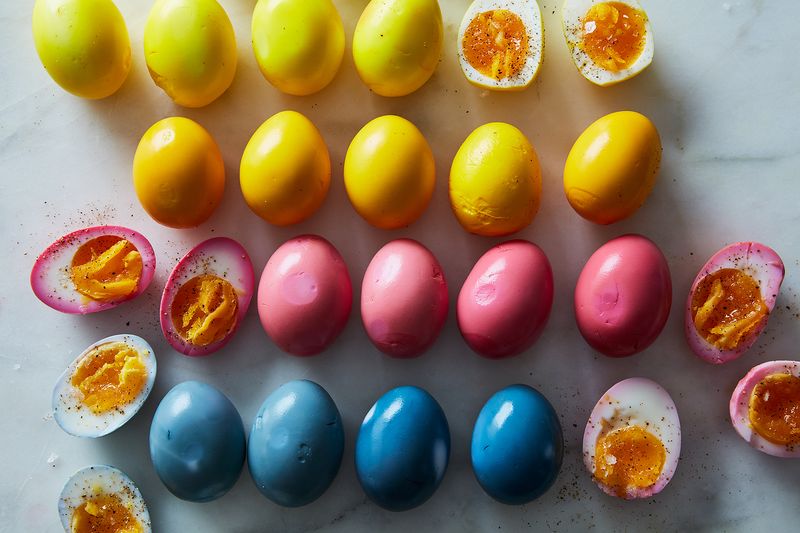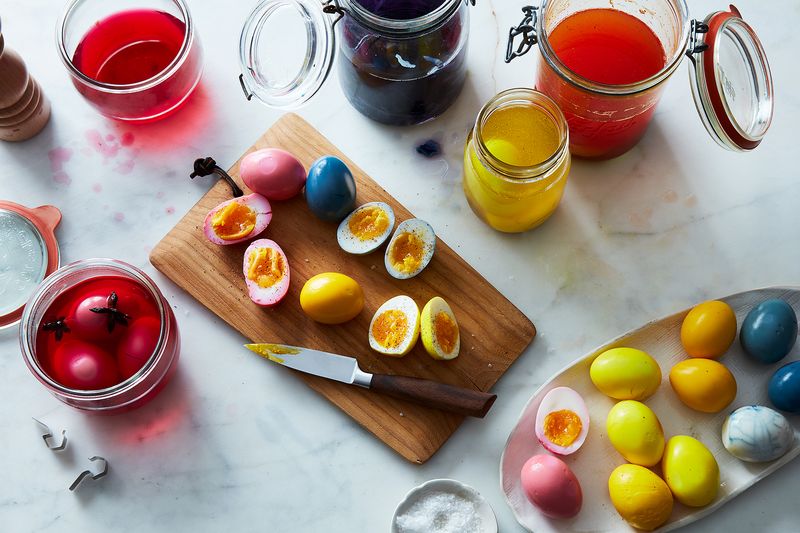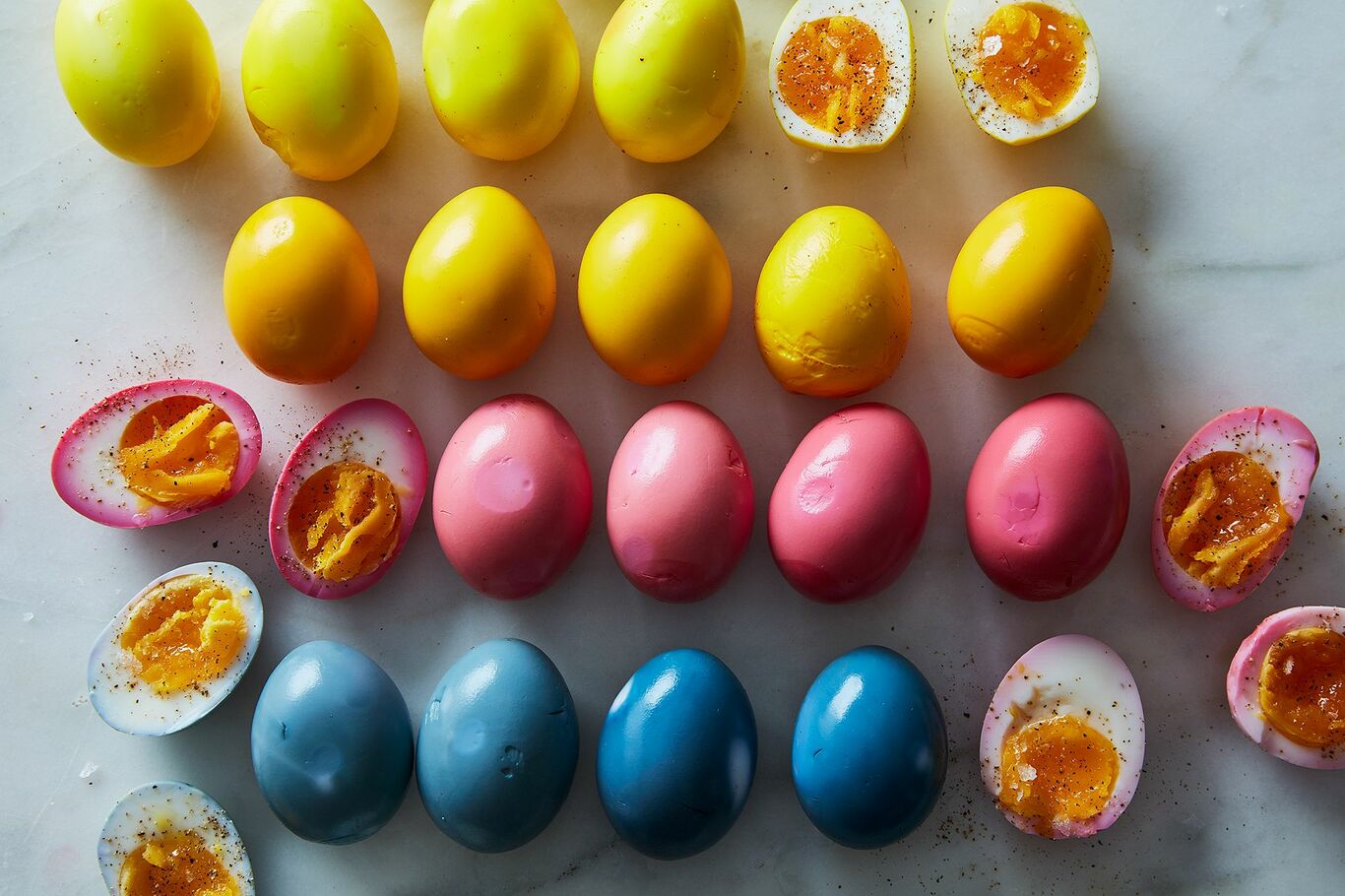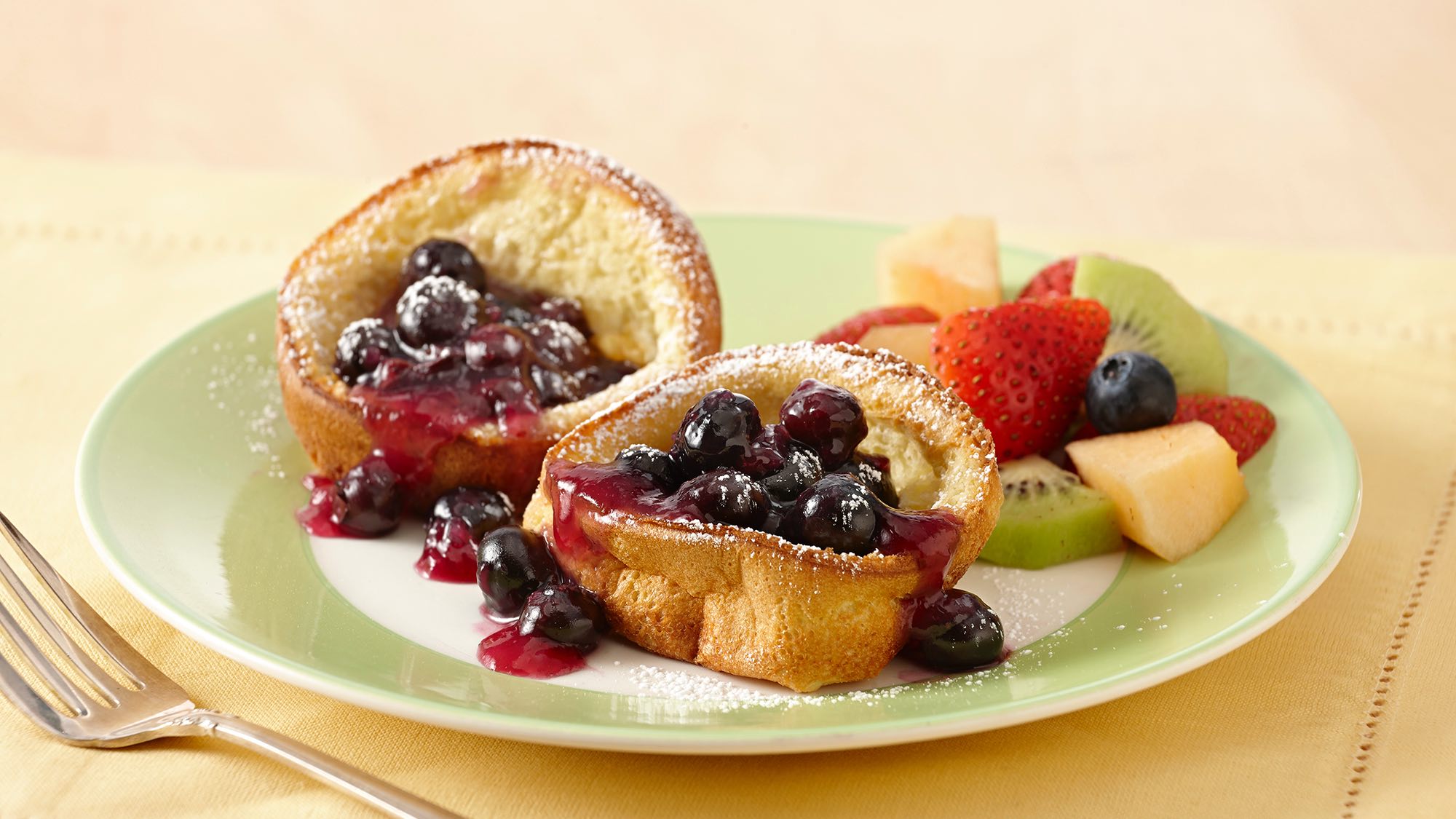You know how people say salt your pasta water so it tastes like the sea? And if you don't, no matter how much you salt your pasta sauce, you're sort of already screwed? Pickling eggs has a similar effect. You can add all the vinegar you want to your egg salad, but using pickled eggs will always be brighter and punchier.
But while eggshells adore natural dyes, egg whites are a bit more... how do we put this nicely... choosy. I tried pickling eggs with parsley, spinach, matcha, carrots, even Korean gochugaru—but all yielded a yellowish-grayish-brown shade of, well, eggshell.
That was before I hit on turmeric, beet, and red cabbage—all ingredients that leave pickled eggs with a vibrant color naturally—and they’re delicious to boot. That means you can showcase these eggs—which are zingy from their vinegar bath (think your favorite quick-pickled carrot, only instead of a carrot, you’ve got an egg)—on the dining table instead of hiding them in your backyard.

Like painted eggs, but better (because you can eat them). Photo by James Ransom
Here’s how to naturally dye pickled eggs without a recipe:
1. Boil the eggs. Each batch of the master brine below will yield enough liquid to cover for four pickled eggs, but feel free to halve or double (or triple!), depending on how many bunnies are attending your Easter.
To start, fill a pot with water and set over high heat. Season with a pinch of salt, plus a splash of white vinegar (apple cider will work, too)—this makes the eggs easier to peel. When the water starts to boil, gingerly add the eggs with a spoon. Boil for 8 minutes. This creates an almost-gooey, half-baked yolk, which will begin to cure in the vinegary brine. For a harder yolk, boil 1 to 2 minutes longer. (Of course, if you have another preferred method of hard-cooking eggs, you can go with that.)
Rinse under cool water and peel while warm. Or if you’d like the marbled effect, do not peel the eggs: Roll them on the surface so that the shell shatters but does not come away from the egg itself. Either way, you can proceed immediately to the brine or store in the fridge for a few days.
2. Make your mother brine. Combine all the following ingredients in a saucepan. Bring to a low simmer to dissolve the sugar and salt.
- 1 1/2 cups white vinegar (or swap out 1/2 cup for a flavorful addition like apple cider, rice, red, or white wine vinegar)
- 1/2 cup water
- 2 tablespoons sugar
- 1 1/4 teaspoons kosher salt

A magical experiment! Photo by James Ransom
3. Now pick your color and your flavorings. Add them to the pot! You’re wondering if the color leads to flavor. The answer: Some more than others. In the case of the pink dye, the eggs will take on a distinctly beet-y taste. And while the purple eggs have notes of caraway, they’re not particularly cabbage-y. The yellow and orange dyes are the most subtle of the bunch, the flavor not far off from that of still-white pickled eggs.
When it comes to adding more flavor to your brine, pretty much all vinegar-pickle principles apply here: Whole spices are ideal, and for a brine this size, I’d recommend sticking with an amount between a teaspoon to a tablespoon, depending on how strong you’d like it. Try black or pink peppercorns, mustard seeds, coriander seeds, cumin seeds, caraway seeds, or red pepper flakes. You can also experiment with herbs: Dill would work beautifully here, and tarragon would be nice in the more subtle orange brine.
Add the ingredients for one color (these quantities correspond to one batch of the brine) and stir until saturated. Turn off the heat.
Pink
- 2 small beets, roasted, peeled, and quartered
- 2 star anise pods
Yellow
- 2 teaspoons ground turmeric
- 1 teaspoon ground ginger
- 1 teaspoon ground mustard
Orange
Mix together the pink and yellow recipes and you yield the best of both worlds—a bright tangerine. Leave the beet in the brine for at least an hour, then check the color. The longer it sticks around, the rosier the brine will become. Bring the mixture back to a simmer before you pour it over the eggs.
- 2 teaspoons ground turmeric
- 2 chunks of roasted beet the size of wine corks
Purple
Red cabbage is the chameleon of the vegetable world. Boil it in water and you get a deep purple liquid. But play with the pH level (how basic or acidic the solution is) and you can go from blue to green to pink. Because pickle brine is vinegar-based, you need some baking soda to balance the solution from magenta to lavender. It will fizz and fuss, but that’s just right.
- 2 cups shredded red cabbage
- 1 tablespoon caraway seeds
- 2 3/4 teaspoons baking soda
4. Dye. Place the eggs in a jar with a tight-fitting, good-sealing lid (those asparagus-sized mason jars work well). Pour the hot brine and its colorful add-ins on top. Secure the lid, then turn the jar upside down a couple of times to make sure the heat of the brine has touched all parts of the jar (and that every egg is fully submerged).
5. Choose your shade. The eggs’ saturation—and sourness—depends entirely on how long they bathe. You can remove them as early as an hour or leave them there for weeks. To create an ombré effect, with a gradient of shades, pull the eggs progressively.
If you’re eating the pickled eggs that day, you can keep them on the counter. But any longer than that, transfer them to the fridge (and remove them from the brine within the week).

You will also need to take a moment to marvel at what you've created. Photo by James Ransom
6. Eat! If you’ve used ground spices in the brine, consider giving your eggs a quick rinse before digging in. Then, eat them as is or use them where you’d normally use hard- or soft-boiled eggs for a bright and punchy flavor base:
- Pink Deviled Eggs: Slice the eggs in half. Separate the yolks into a bowl and mix with mayonnaise, Dijon, paprika, and cayenne. Spoon or pipe back into the white nooks. Finely dice the beets and sprinkle on top. Garnish with flaky salt and a dill sprig.
- Yellow Curried Egg Salad: Dice or grate the eggs. Add mayonnaise, curry powder, and some chopped celery and scallion. Season with salt to taste. Serve with grainy toast, crackers, or cucumber slices.
- Orange Gribiche Carrots: Finely dice the eggs and mix with olive oil, Dijon, white wine vinegar, capers, sliced cornichons, and chopped parsley. Blanch and shock carrots (preferably small, newly harvested ones!) in salty water. Serve hot or cold with gribiche on top. (Gribiche is also excellent on top of asparagus or pasta.)
- Purple Breakfast Reuben: Melt lots of Swiss cheese on two pieces of rye bread. Sandwich together with thickly sliced eggs, the pickled cabbage, and Thousand Island dressing.
This article was written by Emma Laperruque from Food52 and was legally licensed through the NewsCred publisher network. Please direct all licensing questions to legal@newscred.com.








